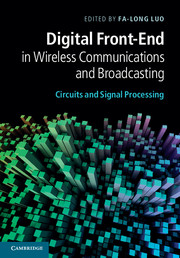Book contents
- Frontmatter
- Contents
- Contributors
- Preface
- Part I Introduction to digital front-end
- Part II DPD and CFR
- 6 General principles and design overview of digital predistortion
- 7 Power amplifier nonlinear modeling for digital predistortion
- 8 Look-up table based digital predistortion schemes and implementation
- 9 Digital predistortion and its combination with crest factor reduction
- 10 Adaptive digital baseband predistortion
- 11 Crest factor reduction techniques
- Part III DUC, DDC, ADC, DAC, and NCO
- Part IV Digital calibration, imbalance compensation, and error corrections
- Part V Circuits and system integration in digital front-end
- Index
- References
9 - Digital predistortion and its combination with crest factor reduction
from Part II - DPD and CFR
Published online by Cambridge University Press: 07 October 2011
- Frontmatter
- Contents
- Contributors
- Preface
- Part I Introduction to digital front-end
- Part II DPD and CFR
- 6 General principles and design overview of digital predistortion
- 7 Power amplifier nonlinear modeling for digital predistortion
- 8 Look-up table based digital predistortion schemes and implementation
- 9 Digital predistortion and its combination with crest factor reduction
- 10 Adaptive digital baseband predistortion
- 11 Crest factor reduction techniques
- Part III DUC, DDC, ADC, DAC, and NCO
- Part IV Digital calibration, imbalance compensation, and error corrections
- Part V Circuits and system integration in digital front-end
- Index
- References
Summary
In wireless communications, it is often desirable to transmit a signal as efficiently as possible to achieve low power dissipation. In the meantime, it is necessary to keep signal distortion small. Unfortunately, these two desirable features contradict each other. For example, it is well known that the radio frequency (RF) power amplifier (PA) in wireless transmitters is inherently nonlinear, and when operated near saturation, it causes inter-modulation products that interfere with adjacent channels. To reduce distortion, a common method is to “back-off” the output power of the PA to ensure that signal peaks do not exceed the saturation point of the amplifier to permit distortion-free transmission. This “back-off” has not been a big concern in narrowband systems, e.g. GSM/EDGE systems, where the modulation exhibits a modest few dB peak-to-average power ratio (PAPR), which degrades efficiencies by around 30 percent that is deemed acceptable. However, the “back-off” could dramatically degrade the PA efficiency in wideband systems because, for example, 3GPP LTE (Long Term Evolution) signals often exhibit PAPRs in excess of 10 dB. Backing off an amplifier to operate within its linear region with these waveforms rapidly forces highly inefficient operation, which can lead to typical efficiencies of less than 10%. That is not acceptable in practical situations.
Digital predistortion (DPD) is proposed to use digital signal processing techniques to compensate for the nonlinear distortion in the RF PA, thereby allowing it to be operated at higher drive levels for higher efficiency [1]. The attraction of this approach is that the nonlinear PA can be linearized by a standalone add-on digital block, freeing vendors from the burden and complexity of manufacturing complex analog/RF circuits. Digital predistortion has become one of the most popular and feasible linearization techniques in modern wireless communication systems.
- Type
- Chapter
- Information
- Digital Front-End in Wireless Communications and BroadcastingCircuits and Signal Processing, pp. 244 - 279Publisher: Cambridge University PressPrint publication year: 2011
References
- 6
- Cited by



